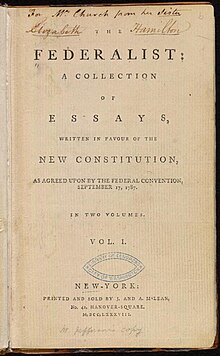 Title page of the first collection of The Federalist (1788). This particular volume was a gift from Alexander Hamilton's wife Elizabeth Schuyler Hamilton to her sister Angelica | |
| Authors | (all under the pseudonym 'Publius') |
|---|---|
| Original title | The Federalist |
| Language | English |
| Publisher |
|
Publication date | October 27, 1787 – May 28, 1788 |
| Publication place | United States |
| Media type |
|
| Part of the Politics series |
| Republicanism |
|---|
|
|
The Federalist Papers is a collection of 85 articles and essays written by Alexander Hamilton, James Madison, and John Jay under the collective pseudonym "Publius" to promote the ratification of the Constitution of the United States. The collection was commonly known as The Federalist until the name The Federalist Papers emerged in the twentieth century.
The first seventy-seven of these essays were published serially in the Independent Journal, the New York Packet, and The Daily Advertiser between October 1787 and April 1788.[1] A compilation of these 77 essays and eight others were published in two volumes as The Federalist: A Collection of Essays, Written in Favour of the New Constitution, as Agreed upon by the Federal Convention, September 17, 1787, by publishing firm J. & A. McLean in March and May 1788.[2][3] The last eight papers (Nos. 78–85) were republished in the New York newspapers between June 14 and August 16, 1788.
The authors of The Federalist intended to influence the voters to ratify the Constitution. In Federalist No. 1, they explicitly set that debate in broad political terms:
It has been frequently remarked, that it seems to have been reserved to the people of this country, by their conduct and example, to decide the important question, whether societies of men are really capable or not, of establishing good government from reflection and choice, or whether they are forever destined to depend, for their political constitutions, on accident and force.[4]
In Federalist No. 10, Madison discusses the means of preventing rule by majority faction and advocates a large, commercial republic. This is complemented by Federalist No. 14, in which Madison takes the measure of the United States, declares it appropriate for an extended republic, and concludes with a memorable defense of the constitutional and political creativity of the Federal Convention.[5]
In Federalist No. 84, Hamilton makes the case that there is no need to amend the Constitution by adding a Bill of Rights, insisting that the various provisions in the proposed Constitution protecting liberty amount to a "bill of rights."[6] Federalist No. 78, also written by Hamilton, lays the groundwork for the doctrine of judicial review by federal courts of federal legislation or executive acts. Federalist No. 70 presents Hamilton's case for a one-man chief executive. In Federalist No. 39, Madison presents the clearest exposition of what has come to be called "Federalism". In Federalist No. 51, Madison distills arguments for checks and balances in an essay often quoted for its justification of government as "the greatest of all reflections on human nature." According to historian Richard B. Morris, the essays that make up The Federalist Papers are an "incomparable exposition of the Constitution, a classic in political science unsurpassed in both breadth and depth by the product of any later American writer."[7]
On June 21, 1788, the proposed Constitution was ratified by the minimum of nine states required under Article VII. In late July 1788, with eleven states having ratified the new Constitution, the process of organizing the new government began.[8]
- ^ Cite error: The named reference
Lloydwas invoked but never defined (see the help page). - ^ The Federalist: a Collection of Essays, Written in Favour of the New Constitution, as Agreed upon by the Federal Convention, September 17, 1787, in two volumes (1st ed.). New York City: J. & A. McLean. 1788. Archived from the original on March 16, 2017.
{{cite book}}:|newspaper=ignored (help) - ^ Jackson, Kenneth T., ed. (1995). The Encyclopedia of New York City. New Haven, Connecticut: Yale University Press. p. 194. ISBN 978-0-300-05536-8.
- ^ The Federalist Papers. Toronto, Ontario, Canada: Bantam Books. 1982. ISBN 9780553210729.
- ^ Wills, x.
- ^ Hamilton, Alexander; Madison, James; Jay, John (2020). The Federalist Papers. New York City: Open Road Integrated Media. ISBN 978-1-5040-6099-8. OCLC 1143829765.
- ^ Morris, Richard B. (1987). The Forging of the Union: 1781–1789. New York City: HarperCollins. p. 309. ISBN 978-0060914240.
- ^ Madison, James; Franklin, Benjamin; Paterson, William; Washington, George; Mason, George; Jefferson, Thomas; Hamilton, Alexander; Jay, John (April 12, 2008). "Convention and Ratification - Creating the United States | Exhibitions - Library of Congress". www.loc.gov. Retrieved 2023-04-11.